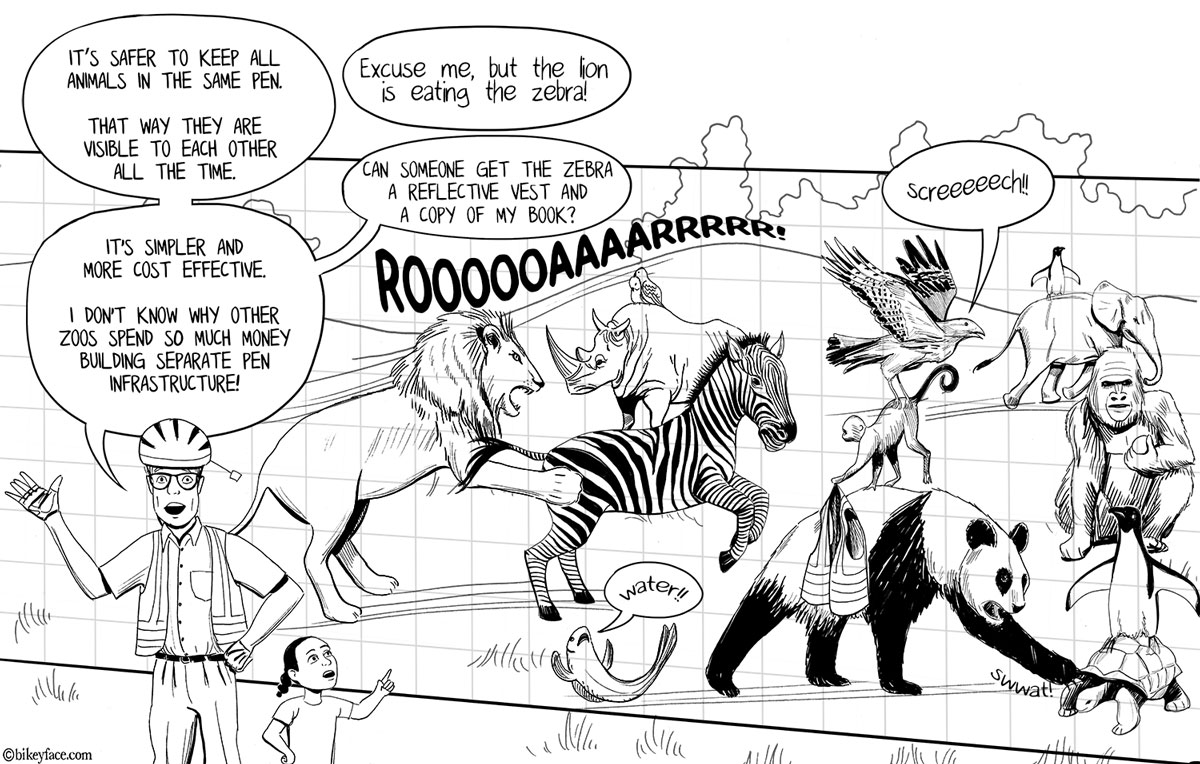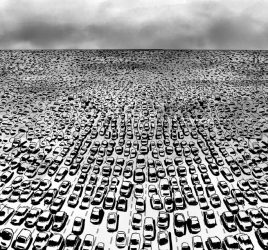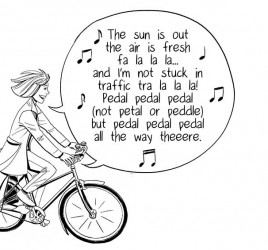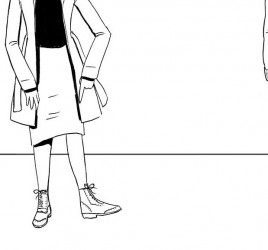
A Zoo
I have to bicycle vehicularly most of the time because there’s not much infrastructure yet. But I’d prefer not to. What I can’t understand why anyone would argue against protected bike lanes.
I wonder how the argument would go if applied to other things- like a zoo?





In my opinion, the Vehicular Cycling crowd is more of a religion than anything else. So we’ve got to use religious methods. My strategy is to resort to telling parables. Here’s my latest…
Once upon a time there was a tribe who lived in a tropical jungle. They called themselves the Upper Swamp (US) tribe to distinguish themselves from the Nether Lice-Infested (NL) tribe that lived downriver.
One thing that both tribes had in common was a serious problem. The jungle was bisected by a river filled with hungry piranhas. That made it a real problem to cross the river! To solve this problem, some members of the US tribe put a lot of effort into devising ways of safely swimming across the river.
These ways were actually very effective. Those men (they were all men) had all kinds of statistics showing how safe their methods were of swimming across the piranha-filled river.
But unfortunately they had little success in convincing their fellow tribe members to adopt their methods. In spite of all their statistics and all their education and training in how to safely swim across the piranha-filled river, only about 1% of the tribe was willing to do so.
And that 1% was mostly men under the age of 65. Women, children and elderly people were simply unwilling to swim across the piranha-filled river, no matter how many times they were berated and told their fears were “phobic fantasies.”
Meanwhile, the NL tribe figured out how to build bridges. Soon almost everyone in the NL tribe was using the bridges. Women and men equally. Elderly people and children used the bridges to cross the river with confidence.
Many people in the US tribe saw what was going on in NL and also started calling for bridges. The men in the US who had figured out the ways of safely swimming across the piranha-filled river were very threatened by this. They started warning about how expensive bridges were.
Some of the first bridges built by members of the US tribe were badly designed. They swayed in the wind and some even collapsed. When this happened, the Safe Swimmer advocates pointed at the poor bridges and said, “Look! This proves that all bridges are bad. Bridges are expensive and dangerous.”
When the NL people saw this they translated their “Design Manual for Bridges” into the language of the US tribe. Some people in some of the smaller villages in the US went to NL or bought their Manual and started building better bridges. Many people in those villages started using the bridges, including women, children and elderly people.
The Safe Swimmer advocates found this very threatening. They came up with more reasons why not to build bridges. They said, “Bridges only work in NL because of their bridge culture. The US is totally different. Our language, laws and customs mean that bridges will never work here.”
Some other members of the US tribe beat their chests and said, “Everything we do is better than that NL tribe. We have nothing to learn from anyone else because we’re the best tribe in the world! Remember during The Big War when that NL tribe was overrun by the Crooked-Cross tribe to the east? It was us who liberated them. That proves we’re the best at everything!”
Well, the older members of the NL tribe who were around during The Big War remembered that most of the fighting to liberate them was actually done by the Beaver tribe who lived to the north of the US. The Beavers had been fighting real hard during the first years of the War when the US tribe remained neutral. And nobody could understand what being good at fighting wars had to do with building bridges anyway.
Meanwhile, one of the largest villages in the US started to build really good bridges across the river. All kinds of people started using them. When they saw how well they worked, more and more people in the US tribe started building and using bridges built to the superior NL designs. After a while, almost everyone was using bridges.
The End.
Alright, I know that the term “vehicular cycling” isn’t about cycling as if the bicycle were a vehicle – which it is, which makes the term so unfortunate – but nonetheless: the biking facilities in the NL are designed under the assumptions that the bike is a vehicle and that bicyclists will follow the laws which apply to vehicles (cf. ride on the right side of the street, stop for red lights, obey traffic signs and so on).
I live in a country where traffic planning (but not the law, NB!) assumes that the bicycle is not a vehicle but a special case of pedestrian, which to me sounds like the opposite of “vehicular cycling”. The results are that between 95 and 99 % of all “cycling infrastructure” consists of narrow former footpaths and pavements which have got the “Combined footpath and cycle path” sign, new infrastructure is constructed in ways that force the bicyclists to regularly bend the laws to do simple things like turning left or crossing the street, and that two or three generations of Swedes don’t know basic traffic rules (cf. cycle on the right side, stop for red lights, obey traffic signs and so on) and are terrified to share the road with even a few cars at low speeds. (See for example this newly rebuilt residential dead-end street: http://www.bicycling.se/cldocpart/13726.jpg)
As long as very few people cycle, as it is in most Swedish cities, it’s a mere nuisance that people cycle on either side of the road, on pavements, at red lights and so on. But if the number of bicyclists rises it becomes a real problem and it’s impossible to take the bicycle infrastructure further without getting rid of this absurd notion that the bicycle is, and should be, considered a pedestrian. It’s an utter waste of money to build Dutch or Danish style infrastructure as long as you at the same time don’t expect the cyclists to know and obey the traffic rules: basicly riding the bike as if it were a vehicle.
Hi Anders,
Yes, bicycles are considered vehicles in the Netherlands. However, they fall under a distinct set of rules for what are know as “Powered Slow Moving Vehicles”. The law accounts for the peculiar nature and characteristics of bicycles and other slow vehicles. They are not a copy-and-paste job on the regulations of general vehicles.
And yes, cyclists are expected to follow those regulations that apply to those “Powered Slow Moving Vehicles”. All school children received road user education, including sessions in a “traffic garden”, before they graduate primary school. That ensures that, as they enter high-school, they are well versed in the rules of the road and the responsible behavior that is expected of them.
Let’s discuss facts, not silly stories.
The fact is that proponents of protected bike lanes are just as much a ‘religion’ as vehicular cyclists. They think raised pavement or markings (not to mention magical plastic hats) will keep them safe, when the ONLY way to be safe is pay attention/be aware of your surroundings. The fact is, accidents happen when people don’t watch where they’re going, or go too fast to react to danger. Slow down. Look around you. Stay safe. It’s that simple.
Riding on a road, or on a protected bike path, will not keep you safe. Riding in a safe manner will. And that’s a fact.
“The fact is that proponents of protected bike lanes are just as much a ‘religion’ as vehicular cyclists.”
Er, no. A religious belief is typically one which is held in the absence of any concrete evidence for it, or – preferably – in the face of abundant evidence to the contrary. By contrast, the belief that segregated cycle tracks (i) encourage mass cycling and (ii) save lives is one massively supported by evidence gathered over many years from the countries and cities around the world that have tried it.
“The fact is, accidents happen when people don’t watch where they’re going, or go too fast to react to danger. Slow down. Look around you. Stay safe. It’s that simple.”
No: accidents happen to cyclists eight times out of ten because drivers of motor vehicles don’t look where they’re going, or drive too fast to react to danger. No amount of education or public-awareness campaigning is going to alter the underlying physics of an object weighing nearly a tonne travelling at 40mph coming into contact with one weighing 70 or 80kg and travelling at 15mph. Not to speak of the driver of one being encased in a robust metal box on four wheels while the other is completely unprotected and falls over if he stops moving. I’m not worried about the 95% of drivers who are careful and conscientious, I’m worried about the irreducible 5% who aren’t.
By the way, the “magical plastic hats” you speak of are not generally worn in countries with good infrastructure because there simply isn’t the need. In my experience the very few cyclists in favour of their being made compulsory for everyone else are the self-styled “Real Cyclists” who view them as part of the dress code, and consider that even if the rest aren’t Real Cyclists like themselves they should at least be made to look the part. The sort of posturing dickheads who claim on blogs to be expert cyclists, then go on to tell everyone how many times they fall off each month.
“…the countries and cities around the world that have tried it.”
Yes, here is a list of 700 cities ranked by bicycle mode share. Cities in all the varieties of human cultures, climate and geography. Guess what all of the high mode share cities have in common?
http://www.cityclock.org/urban-cycling-mode-share/#.VQ9eBPldV8F
Spoiler alert: It’s high-quality cycling infrastructure.
“accidents happen to cyclists eight times out of ten because drivers of motor vehicles don’t look where they’re going, or drive too fast to react to danger.”
This is what the lawyers always say. But, if you’ll notice, many times the driver isn’t even cited for breaking a law, and that’s because the bike rider DID SOMETHING WRONG. But, because the press doesn’t like to ‘blame the victim’, they won’t report on what actually caused the death or accident. You have to read between the lines. So this person didn’t look behind them when they crossed the street, and the motorcyclist crashed into them, or that person went too fast going the ‘wrong way’ on a sidewalk access to the street at the stop light and got hooked by a car. No, it’s ‘always the driver’s fault’, except when it isn’t. This non-reporting doesn’t help anybody learn how to avoid accidents, which is tantamount to encouraging more death and destruction on the roads.
Brilliant
“But, if you’ll notice, many times the driver isn’t even cited for breaking a law, and that’s because the bike rider DID SOMETHING WRONG.”
Excuse me, but which galaxy are you writing from? In Britain, police and Department of Transport statistics confirm that in getting on for 85% of cycling accidents a motor vehicle was involved, and that it was nearly always the motor vehicle hitting the cyclist. Negligent cycling may have been involved in some cases – e.g. running red lights – but most of the time it’s driver error which no amount of cycling skill can guard against.
“But, because the press doesn’t like to ‘blame the victim’, they won’t report on what actually caused the death or accident.”
Again, where do you live? In Britain the press always blames the cyclist: basically for having been on the road at all “getting in the way of cars” (…and not wearing a helmet even when it was a left-turning 40-tonne truck that crushed them). It’s the country where – apparently – cycling with the rising or setting sun ahead of you is a road-traffic offence punishable by death.
@Shawn
Your post seems to consist of just a string of obvious falsehoods! Please tell me you are just trolling and don’t actually believe any of that stuff?
You say ‘lets discuss facts’ but then don’t provide any!
In fact, you completely ignore all the available facts – such as the fact that official statistics (not to mention most cyclists’ personal experience) clearly demonstrate that most ‘accidents’ involving motorists and cyclists are due to errors by the former, not the latter.
Accidents happen when _people in cars_ don’t watch where they are going…etc. Please explain, how do I, on my bike, have any control over that?
Riding in a safe manner will NOT keep you safe, you are dangerously and absurdly ignoring reality if you think that (do you want links to all the reports of cases where cyclists riding correctly, with high viz and lights etc, were killed after being run down from behind by drivers? One could start with the recent Regent’s Street case, but there are many, many others.)
Its odd that its always the folk who talk most loudly about ‘facts’ and ‘common sense’ who don’t seem to have any of either!
This intersection problem you guys are all complaining about has little to do with separated bike infrastructure (which, regardless of its safety impact, is absolutely essential to getting the bike commuter rate above 1-2%), and it is a solved problem:
http://www.protectedintersection.com/
“This intersection problem you guys are all complaining about has little to do with separated bike infrastructure”
It’s typical of segregated cycle tracks à l’anglaise – that is, where there are any – which have a habit of disappearing just where you need them most, abruptly decanting you back into fast and dense traffic where the road narrows. But that’s not a problem of segregated infrastructure, it’s a problem of poorly -planned segregated infrastructure done on the cheap by people who have no idea what they’re trying to achieve or why. Go to countries where they do things properly and you’ll immediately see the difference.
And now for my jab at the comic:
I think if zoos had to remove on-street parking in order to give the animals separate pens, this comic shows exactly how things would be. 😉
I don’t have a problem with protected bike lanes. My problem comes from some posts seem to imply that they are the only solution. As an example, the street I live on is a quiet residential street. Daily car volume is less than 500 cars per day. Also the street is narrow with parking on both sides so the traffic moves about 15 to 20 mph. On that street a protected bike lane is a waste of money. Two blocks over is a major arterial with well over 10,000 cars per day. That street probably needs a protected bike lane. What it has currently is both a MUP and an on street painted bike lane which actually seems to work quite well.
“I don’t have a problem with protected bike lanes. My problem comes from some posts seem to imply that they are the only solution.”
Has anyone suggested that? Or implied that all roads should be segregated regardless of whether they need it or not?
Quite as important as segregated tracks in making Dutch cycling so ubiquitous, safe and pleasant is that country’s law of strict liability – shared by all but four states in the European Union – which lays down that in the event of a motor vehicle hitting a cyclist the vehicle’s driver will be assumed to be at fault unless it can be shown otherwise. Another factor is that the Dutch driving test contains a cyclist-awareness module, and that cycle training is part of the junior-school curriculum. And then there’s the sheer numbers of cyclists: when you drive in Holland anywhere but on a main arterial road you’re always on the lookout for them.
As I’ve pointed out already, only some 22% of the total Dutch metalled-road kilometrage is cycle-tracked: everywhere else it’s shared-use with painted strips along the road edges. But the 22% are the fast, busy roads where accidents would otherwise be most likely to occur.
“What it has currently is both a MUP and an on street painted bike lane which actually seems to work quite well.”
…Much as London’s present traffic free-for-all works quite well for the few thousand cyclists brave or masochistic enough to use it each day. The point is that it doesn’t work at all for the many hundreds of thousands who might otherwise use it.
Instead of coming up with fantastic and not so accurate analogies, why not come up with facts, or at least personal stories that have some basis. In particular if you or your readers could come up with at least a few actual examples of safe infrastructure that isn’t presenting some sort of latent hazards at intersections. Google maps street view for example.
Honestly there are a lot of well intentioned traffic engineering but none have been successful.
Elias, just StreetView around Amsterdam and its suburbs. There are tons of perfectly good examples of how the Dutch have integrated their segregated bike network into the road system and how they have achieved an integrated safe flow for both vehicles and bikes for absolutely ALL users, from 13 year old high-school students to grand-parents, men and women alike.
Does North America face a challenge achieving such a safe and well integrated mobility network… SURE! The Dutch have a 40 year lead over us. Is the gap impossible to bridge??? No… but it takes political will to get the ball rolling and to start asking some serious questions about mobility in North Amercia in the 21st Century.